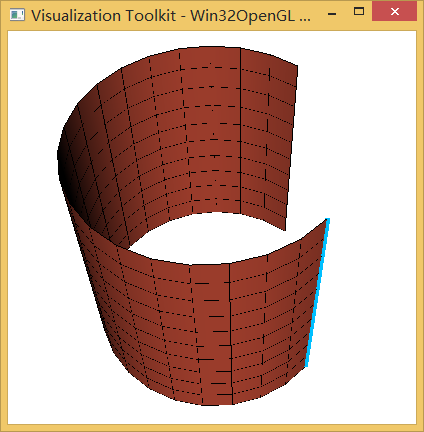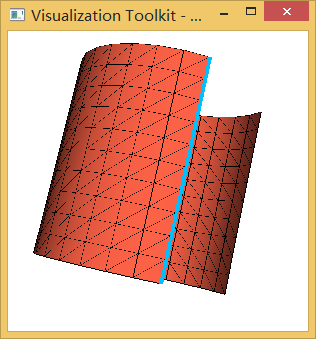vtk旋转扫描实体示例:vtkQuadRotationalExtrusionFilter、vtkRotationalExtrusionFilter
一、vtkQuadRotationalExtrusionFilter
Detailed Description
sweep polygonal data creating "skirt" from free edges and lines, and lines from vertices
vtkQuadRotationalExtrusionFilter is a modeling filter. It takes polygonal data as input and generates polygonal data on output. The input dataset is swept around the z-axis to create new polygonal primitives. These primitives form a "skirt" or swept surface. For example, sweeping a line results in a cylindrical shell, and sweeping a circle creates a torus.
There are a number of control parameters for this filter. You can control whether the sweep of a 2D object (i.e., polygon or triangle strip) is capped with the generating geometry via the "Capping" instance variable. Also, you can control the angle of rotation, and whether translation along the z-axis is performed along with the rotation. (Translation is useful for creating "springs".) You also can adjust the radius of the generating geometry using the "DeltaRotation" instance variable.
The skirt is generated by locating certain topological features. Free edges (edges of polygons or triangle strips only used by one polygon or triangle strips) generate surfaces. This is true also of lines or polylines. Vertices generate lines.
This filter can be used to model axisymmetric objects like cylinders, bottles, and wine glasses; or translational/rotational symmetric objects like springs or corkscrews.
- Warning:
- If the object sweeps 360 degrees, radius does not vary, and the object does not translate, capping is not performed. This is because the cap is unnecessary.
- Some polygonal objects have no free edges (e.g., sphere). When swept, this will result in two separate surfaces if capping is on, or no surface if capping is off.
- Thanks:
- This class was initially developed by Daniel Aguilera, CEA/DIF Ported and modified by Philippe Pebay, Kitware, 2011
Definition at line 74 of file vtkQuadRotationalExtrusionFilter.h.
示例代码:
#ifndef INITIAL_OPENGL
#define INITIAL_OPENGL
#include <vtkAutoInit.h>
VTK_MODULE_INIT(vtkRenderingOpenGL)
VTK_MODULE_INIT(vtkInteractionStyle)
#endif
#include <iostream> using namespace std;
#include "vtkCamera.h"
#include "vtkInformation.h"
#include "vtkLineSource.h"
#include "vtkMultiBlockDataSet.h"
#include "vtkNew.h"
#include "vtkPolyDataMapper.h"
#include "vtkPolyDataNormals.h"
#include "vtkProperty.h"
#include "vtkRegressionTestImage.h"
#include "vtkRenderer.h"
#include "vtkRenderWindow.h"
#include "vtkRenderWindowInteractor.h"
#include "vtkQuadRotationalExtrusionFilter.h"
#include "vtkTestUtilities.h"
int main()
{
// Create a line source
vtkNew<vtkLineSource> line;
line->SetPoint1( ., ., . );
line->SetPoint2( ., ., . );
line->SetResolution( );
line->Update(); // Create mapper for line segment
vtkNew<vtkPolyDataMapper> lineMapper;
lineMapper->SetInputConnection( line->GetOutputPort() ); // Create actor for line segment
vtkNew<vtkActor> lineActor;
lineActor->SetMapper( lineMapper.GetPointer() );
lineActor->GetProperty()->SetLineWidth( );
lineActor->GetProperty()->SetColor( ., ., . ); // deep sky blue // Create multi-block data set for quad-based sweep
vtkNew<vtkMultiBlockDataSet> lineMB;
lineMB->SetNumberOfBlocks( );
lineMB->GetMetaData( static_cast<unsigned>( ) )->Set( vtkCompositeDataSet::NAME(), "Line" );
lineMB->SetBlock( , line->GetOutput() ); // Create 3/4 of a cylinder by rotational extrusion
vtkNew<vtkQuadRotationalExtrusionFilter> lineSweeper;
lineSweeper->SetResolution( );
lineSweeper->SetInputData( lineMB.GetPointer() );
lineSweeper->SetDefaultAngle( );
lineSweeper->Update(); // Retrieve polydata output
vtkMultiBlockDataSet* cylDS = vtkMultiBlockDataSet::SafeDownCast( lineSweeper->GetOutputDataObject( ) );
vtkPolyData* cyl = vtkPolyData::SafeDownCast( cylDS->GetBlock( ) ); // Create normals for smooth rendering
vtkNew<vtkPolyDataNormals> normals;
normals->SetInputData( cyl ); // Create mapper for surface representation
vtkNew<vtkPolyDataMapper> cylMapper;
cylMapper->SetInputConnection( normals->GetOutputPort() );
cylMapper->SetResolveCoincidentTopologyToPolygonOffset(); // Create mapper for wireframe representation
vtkNew<vtkPolyDataMapper> cylMapperW;
cylMapperW->SetInputData( cyl );
cylMapperW->SetResolveCoincidentTopologyToPolygonOffset(); // Create actor for surface representation
vtkNew<vtkActor> cylActor;
cylActor->SetMapper( cylMapper.GetPointer() );
cylActor->GetProperty()->SetRepresentationToSurface();
cylActor->GetProperty()->SetInterpolationToGouraud();
cylActor->GetProperty()->SetColor( ., 0.3882, . ); // tomato // Create actor for wireframe representation
vtkNew<vtkActor> cylActorW;
cylActorW->SetMapper( cylMapperW.GetPointer() );
cylActorW->GetProperty()->SetRepresentationToWireframe();
cylActorW->GetProperty()->SetColor( ., ., .);
cylActorW->GetProperty()->SetAmbient( . );
cylActorW->GetProperty()->SetDiffuse( . );
cylActorW->GetProperty()->SetSpecular( . ); // Create a renderer, add actors to it
vtkNew<vtkRenderer> ren1;
ren1->AddActor( lineActor.GetPointer() );
ren1->AddActor( cylActor.GetPointer() );
ren1->AddActor( cylActorW.GetPointer() );
ren1->SetBackground( ., ., . ); // Create a renderWindow
vtkNew<vtkRenderWindow> renWin;
renWin->AddRenderer( ren1.GetPointer() );
renWin->SetSize( , );
renWin->SetMultiSamples( ); // Create a good view angle
vtkNew<vtkCamera> camera;
camera->SetClippingRange( 0.576398, 28.8199 );
camera->SetFocalPoint( 0.0463079, -0.0356571, 1.01993 );
camera->SetPosition( -2.47044, 2.39516, -3.56066 );
camera->SetViewUp( 0.607296, -0.513537, -0.606195 );
ren1->SetActiveCamera( camera.GetPointer() ); // Create interactor
vtkNew<vtkRenderWindowInteractor> iren;
iren->SetRenderWindow( renWin.GetPointer() );
// Render and test
renWin->Render();
iren->Start(); return ;
}
运行显示结果:

2、vtkRotationalExtrusionFilter
Detailed Description
sweep polygonal data creating "skirt" from free edges and lines, and lines from vertices
vtkRotationalExtrusionFilter is a modeling filter. It takes polygonal data as input and generates polygonal data on output. The input dataset is swept around the z-axis to create new polygonal primitives. These primitives form a "skirt" or swept surface. For example, sweeping a line results in a cylindrical shell, and sweeping a circle creates a torus.
There are a number of control parameters for this filter. You can control whether the sweep of a 2D object (i.e., polygon or triangle strip) is capped with the generating geometry via the "Capping" instance variable. Also, you can control the angle of rotation, and whether translation along the z-axis is performed along with the rotation. (Translation is useful for creating "springs".) You also can adjust the radius of the generating geometry using the "DeltaRotation" instance variable.
The skirt is generated by locating certain topological features. Free edges (edges of polygons or triangle strips only used by one polygon or triangle strips) generate surfaces. This is true also of lines or polylines. Vertices generate lines.
This filter can be used to model axisymmetric objects like cylinders, bottles, and wine glasses; or translational/rotational symmetric objects like springs or corkscrews.
- Warning:
- If the object sweeps 360 degrees, radius does not vary, and the object does not translate, capping is not performed. This is because the cap is unnecessary.
- Some polygonal objects have no free edges (e.g., sphere). When swept, this will result in two separate surfaces if capping is on, or no surface if capping is off.
- See also:
- vtkLinearExtrusionFilter
- Examples:
- vtkRotationalExtrusionFilter (Examples)
示例代码:
#include <iostream>
#ifndef INITIAL_OPENGL
#define INITIAL_OPENGL
#include <vtkAutoInit.h>
VTK_MODULE_INIT(vtkRenderingOpenGL)
VTK_MODULE_INIT(vtkInteractionStyle)
#endif
using namespace std;
// .SECTION Thanks
// This test was written by Philippe Pebay, Kitware SAS 2011 #include "vtkCamera.h"
#include "vtkLineSource.h"
#include "vtkNew.h"
#include "vtkPolyDataMapper.h"
#include "vtkPolyDataNormals.h"
#include "vtkProperty.h"
#include "vtkRegressionTestImage.h"
#include "vtkRenderer.h"
#include "vtkRenderWindow.h"
#include "vtkRenderWindowInteractor.h"
#include "vtkRotationalExtrusionFilter.h" int main()
{
// Create a line source
vtkNew<vtkLineSource> line;
line->SetPoint1( ., ., . );
line->SetPoint2( ., ., . );
line->SetResolution( ); // Create mapper for line segment
vtkNew<vtkPolyDataMapper> lineMapper;
lineMapper->SetInputConnection( line->GetOutputPort() ); // Create actor for line segment
vtkNew<vtkActor> lineActor;
lineActor->SetMapper( lineMapper.GetPointer() );
lineActor->GetProperty()->SetLineWidth( );
lineActor->GetProperty()->SetColor( ., ., . ); // deep sky blue // Create 3/4 of a cylinder by rotational extrusion
vtkNew<vtkRotationalExtrusionFilter> lineSweeper;
lineSweeper->SetResolution( );
lineSweeper->SetInputConnection( line->GetOutputPort() );
lineSweeper->SetAngle( ); // Create normals for smooth rendering
vtkNew<vtkPolyDataNormals> normals;
normals->SetInputConnection( lineSweeper->GetOutputPort() ); // Create mapper for surface representation
vtkNew<vtkPolyDataMapper> cylMapper;
cylMapper->SetInputConnection( normals->GetOutputPort() );
cylMapper->SetResolveCoincidentTopologyToPolygonOffset(); // Create mapper for wireframe representation
vtkNew<vtkPolyDataMapper> cylMapperW;
cylMapperW->SetInputConnection( lineSweeper->GetOutputPort() );
cylMapperW->SetResolveCoincidentTopologyToPolygonOffset();
// Create actor for surface representation
vtkNew<vtkActor> cylActor;
cylActor->SetMapper( cylMapper.GetPointer() );
cylActor->GetProperty()->SetRepresentationToSurface();
cylActor->GetProperty()->SetInterpolationToGouraud();
cylActor->GetProperty()->SetColor( ., ., . ); // tomato
// Create actor for wireframe representation
vtkNew<vtkActor> cylActorW;
cylActorW->SetMapper( cylMapperW.GetPointer() );
cylActorW->GetProperty()->SetRepresentationToWireframe();
cylActorW->GetProperty()->SetColor( ., ., .);
cylActorW->GetProperty()->SetAmbient( . );
cylActorW->GetProperty()->SetDiffuse( . );
cylActorW->GetProperty()->SetSpecular( . );
// Create a renderer, add actors to it
vtkNew<vtkRenderer> ren1;
ren1->AddActor( lineActor.GetPointer() );
ren1->AddActor( cylActor.GetPointer() );
ren1->AddActor( cylActorW.GetPointer() );
ren1->SetBackground( ., ., . ); // Create a renderWindow
vtkNew<vtkRenderWindow> renWin;
renWin->AddRenderer( ren1.GetPointer() );
renWin->SetSize( , );
renWin->SetMultiSamples( );
// Create a good view angle
vtkNew<vtkCamera> camera;
camera->SetClippingRange( 0.576398, 28.8199 );
camera->SetFocalPoint( 0.0463079, -0.0356571, 1.01993 );
camera->SetPosition( -2.47044, 2.39516, -3.56066 );
camera->SetViewUp( 0.607296, -0.513537, -0.606195 );
ren1->SetActiveCamera( camera.GetPointer() ); // Create interactor
vtkNew<vtkRenderWindowInteractor> iren;
iren->SetRenderWindow( renWin.GetPointer() ); // Render and test
renWin->Render();
iren->Start(); return ;
}
代码运行结果:

vtk旋转扫描实体示例:vtkQuadRotationalExtrusionFilter、vtkRotationalExtrusionFilter的更多相关文章
- 应用程序框架实战三十四:数据传输对象(DTO)介绍及各类型实体比较
本文将介绍DDD分层架构中广泛使用的数据传输对象Dto,并且与领域实体Entity,查询实体QueryObject,视图实体ViewModel等几种实体进行比较. 领域实体为何不能一统江湖? 当你阅读 ...
- 数据传输对象(DTO)介绍及各类型实体比较
数据传输对象(DTO)介绍及各类型实体比较 本文将介绍DDD分层架构中广泛使用的数据传输对象Dto,并且与领域实体Entity,查询实体QueryObject,视图实体ViewModel等几种实体进行 ...
- Rookey.Frame之实体类
上周跟大家分享了Rookey.Frame框架的初始化功能,今天继续给大家介绍实体类的设计. 先看下下面菜单实体示例代码: using Rookey.Frame.EntityBase; using Ro ...
- ABP框架 - 数据过滤
文档目录 本节内容: 简介 预定义过滤 ISoftDelete 何时可用? IMustHaveTenant 何时可用? IMayHaveTenant 何时可用? 禁用过滤 关于using声明 关于多租 ...
- EF CodeFirst EntityTypeConfiguration 自关联映射配置
实体示例代码: public class Message { public Message() { } public int ID { get; private set; } public strin ...
- c# SqlHelper Class
using System;using System.Collections;using System.Collections.Generic;using System.Data;using Syste ...
- WPF学习之路初识
WPF学习之路初识 WPF 介绍 .NET Framework 4 .NET Framework 3.5 .NET Framework 3.0 Windows Presentation Found ...
- Entity Framework Core 2.0 全局查询过滤器
不定时更新翻译系列,此系列更新毫无时间规律,文笔菜翻译菜求各位看官老爷们轻喷,如觉得我翻译有问题请挪步原博客地址 本博文翻译自: http://gunnarpeipman.com/2017/08/ef ...
- 基于EF Core的Code First模式的DotNetCore快速开发框架
前言 最近接了几个小单子,因为是小单子,项目规模都比较小,业务相对来说,也比较简单.所以在选择架构的时候,考虑到效率方面的因素,就采取了asp.net+entity framework中的code f ...
随机推荐
- HDU - 6583 Typewriter (后缀自动机+dp)
题目链接 题意:你要打印一段字符串,往尾部添加一个字符需要花费p元,复制一段字符到尾部需要花费q元,求打印完全部字符的最小花费. 一开始想的贪心,后来发现忘了考虑p<q的情况了,还纳闷怎么不对. ...
- hihocoder1384/CH0601 Genius ACM[贪心+倍增+归并排序]
提交地址. 关于lyd给的倍增方法,即从当前枚举向后的$2^k$长度($k$从$1$开始),如果可行就将$k$加一以扩大范围,不可行时将范围不断减半直至$0$. 举个例子,假设当下在1,目标答案是13 ...
- vue-router嵌套路由,二级路由。
如果全是用一级路由时,路由管理就变得很臃肿,有点乱,路由有父子关系的话,嵌套路由会更好.嵌套也就是路由中的路由的意思,组件中可以有自己的路由导航和路由容器(router-link.router-vie ...
- 如何配置IIS使其支持APK/WGT文件的下载
1.打开Internet 信息服务(IIS)管理器: 2.选择需要配置的网站: 3.右侧功能界面双击进入“MIME类型”: 4.点击右侧“添加”按钮,在弹出窗口里文件扩展名输入:apk,MIME类型输 ...
- shell中+,*,[:space:]的用法
http://blog.itpub.net/27181165/viewspace-1061688/ 在linux中通常会使用shell结合正则表达式来过滤字符,本文将以一个简单的例子来说明+,*,[: ...
- qq在线咨询
<a href="http://wpa.qq.com/msgrd?v=3&uin=2395848377&site=qq&menu=yes"> & ...
- 如何开始使用 Akka
如果你是第一次开始使用 Akka,我们推荐你先运行简单的 Hello World 项目.情况参考 Quickstart Guide 页面中的内容来下载和运行 Hello World 示例程序.上面链 ...
- [游记]CSP2019-S
Day 1 开局看到T1格雷码,哇塞这不是初赛原题???10分钟高精打完离场. T2是个什么题目,看起来不难,15分钟码完,调了5分钟,过了样例2 欸,为什么样例3过不掉?仔细一看发现爆栈了,一慌忘记 ...
- Keil工程Lib库文件的制作和运用
最近看了百度手环开源项目,发现所有的算法都被封装成了一个lib文件在keil中调用 也是第一次学习到. 问题引出:为什么要做成lib库? 1.有些方案公司为了将自己写的关键部分源代码不进行公开,但是同 ...
- JavaWeb_响应和请求数据包
Google浏览器 F12中Network->Header部分 <%@ page language="java" import="java.util.*&qu ...
